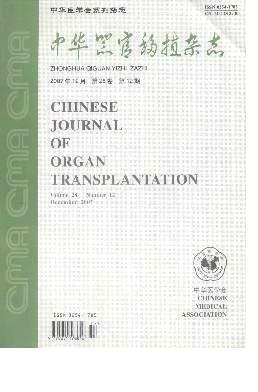Multivariate analysis of risk factors for clinically overt hemorrhagic cystitis after allogeneic hematopoietic stem cell transplantation
引用次数: 0
Abstract
Objective To analyze the risk factors of clinically overt hemorrhagic cystitis(HC)(grade ≥Ⅱ) in 114 patients undergoing allogeneic hematopoietic stem cell transplantation(allo-HSCT) to predict the occurrence of HC.Methods We retrospectively analyzed 29 cases of clinically overt HC from a series of 114 patients subject to allo-HSCT from April 1997 to December 2004.The time of follow-up began from the day of initiating conditioning to day 180 post-transplant.The 11 clinical parameters were selected for univariate analysis using a Cox regression: age,sex,underlying disease,conditioning regimen,disease status at transplant,aGVHD,donor type,use of ATG,GVHD prophylaxis,platelet and neutrophil engraftment.Factors that were significant at the 0.1 level on univariate analysis were evaluated by multivariate analysis using a Cox regression.The cumulative incidence of grade ≥Ⅱ HC within the day 180 after transplantation was calculated by the method of Kaplan and Meier.Results Twenty-nine out of 114 patients(26 %) developed HC with grade Ⅱ in 12/29 cases(41.4 %),grade Ⅲ in 11/29 cases(37.9 %) and grade Ⅳ in 6/29 cases(20.7 %).The following factors were associated with an increased risk of HC by univariate analysis: male gender(RR=2.885,P=0.021),younger than 26 years(RR=3.265,P=0.002),gradeⅢ~Ⅳ aGVHD(RR=4.039,P=0.002),unrelated donor(RR=4.347,P=0.000),intense GVHD prophylaxis(RR=2.218,P=0.045),advanced disease(RR=2.668,P=0.009).These risk factors were entered into a multivariate model.Only male gender(RR=2.993,95 % CI 1.218-7.358;P=0.017) and unrelated donor(RR=4.478,95 % CI 2.049-9.786;P=0.000) were identified as being significantly associated with the occurrence of HC.Conclusion In multivariate analysis,patients were at increased risk of HC if they were male or had received grafts from unrelated donors.异基因造血干细胞移植后临床显性出血性膀胱炎危险因素的多因素分析
目的分析114例同种异体造血干细胞移植(alloo - hsct)患者临床公开性出血性膀胱炎(HC)(分级≥Ⅱ)的危险因素,预测HC的发生。方法回顾性分析1997年4月至2004年12月接受同种异体造血干细胞移植的114例患者中29例临床显性HC。随访时间从开始调节之日起至移植后第180天。选择11个临床参数进行单因素Cox回归分析:年龄、性别、基础疾病、调节方案、移植时疾病状态、aGVHD、供体类型、ATG使用、GVHD预防、血小板和中性粒细胞植入。单因素分析在0.1水平上显著的因素采用Cox回归进行多因素分析。采用Kaplan和Meier方法计算移植后180天内≥Ⅱ级HC的累积发生率。结果114例患者中29例(26%)发生HC, 12/29例为Ⅱ级(41.4%),11/29例为Ⅲ级(37.9%),6/29例为Ⅳ级(20.7%)。单因素分析显示:男性(RR=2.885,P=0.021)、26岁以下(RR=3.265,P=0.002)、Ⅲ~ⅣaGVHD分级(RR=4.039,P=0.002)、非亲属供体(RR=4.347,P=0.000)、GVHD强烈预防(RR=2.218,P=0.045)、疾病晚期(RR=2.668,P=0.009)与HC风险增加相关。这些危险因素被输入一个多变量模型。只有男性(RR=2.993, 95% CI 1.218 ~ 7.358, P=0.017)和非亲属供体(RR=4.478, 95% CI 2.049 ~ 9.786, P=0.000)与HC的发生有显著相关性。结论在多因素分析中,男性患者或接受非亲属供体移植的患者发生丙型肝炎的风险增加。
本文章由计算机程序翻译,如有差异,请以英文原文为准。
求助全文
约1分钟内获得全文
求助全文

 求助内容:
求助内容: 应助结果提醒方式:
应助结果提醒方式:


